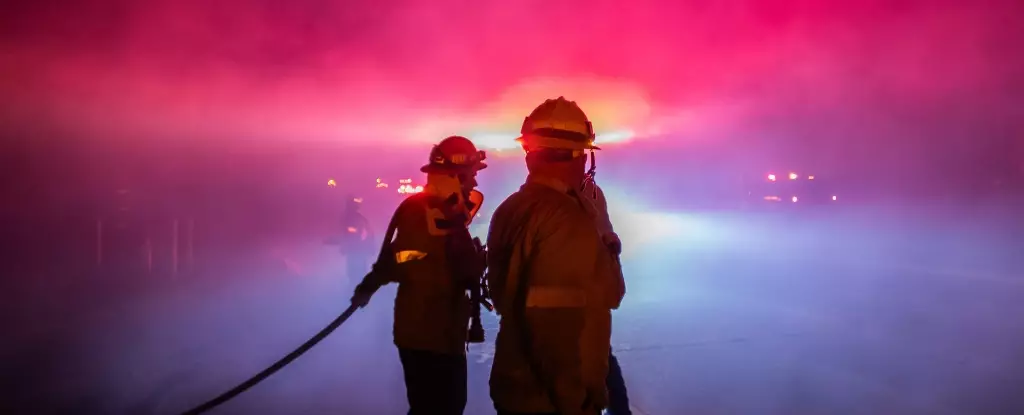The Franklin Fire, which ignited late Monday in the scenic hills above Pepperdine University, has turned the idyllic Malibu landscape into a site of chaos and urgency. Over the course of just a few days, this wildfire claimed at least seven homes in one of California’s most affluent neighborhoods, causing mass evacuations and creating a palpable sense of fear among residents and celebrities alike. Approximately 20,000 individuals were ordered to evacuate their residences as the blaze, fueled by fierce winds and steep canyons, ravaged approximately 4,000 acres (or 1,600 hectares) of land. Despite the sheer scale of destruction, the firefighting crews have demonstrated remarkable resilience, employing a combination of ground tactics and aerial support to combat the fire.
Firefighters have faced an uphill battle against the Franklin Fire, with around 1,500 personnel combating the relentless flames. The Los Angeles County Fire Chief, Anthony Marrone, provided updates on the situation, stating that while some containment had been achieved, the fire’s western front was still actively spreading. The harsh weather conditions, characterized by strong Santa Ana winds and low humidity levels, posed significant threats to containment efforts, further complicating the battle against the blaze. Marrone emphasized the importance of monitoring these conditions, declaring that the ongoing red flag warnings indicate a particularly dangerous situation for the surrounding communities.
In an attempt to manage the chaos, local law enforcement officials began door-to-door evacuations almost immediately after the fire’s outbreak. The urgency was palpable, as many residents had little time to gather belongings, relying instead on the swift actions of first responders. The ordeal was felt even by icons like Dick Van Dyke, who shared heartfelt concerns for their community on social media, illustrating how crises like this have a far-reaching impact, extending beyond borders and affecting even the most celebrated figures.
Malibu is often portrayed as a haven for Hollywood’s elite, with homes belonging to celebrities such as Lady Gaga, Leonardo DiCaprio, and Jennifer Aniston dotting the coastline. The Franklin Fire put a spotlight on the vulnerabilities faced not only by ordinary residents but also by individuals who typically bask in the comforts of celebrity life. As news spread rapidly through social media and news outlets, a sense of unity emerged among those facing the fire’s wrath. Residents expressed concerns for their community’s survival, engaging in conversations about safety, resilience, and collective responses to such disasters.
Nevertheless, the incident also highlights the precarious nature of living in areas prone to wildfires. Many of these celebrities are not merely guardians of their mansions; they are also advocates for environmental awareness, often involved in various charitable causes aimed at climate action and disaster relief. Their involvement raises questions about the effectiveness of current fire management practices and land policies that have failed to mitigate the growing frequency and intensity of wildfires in California.
The Franklin Fire isn’t an isolated occurrence but rather part of a disturbing pattern that scientists attribute largely to climate change. The growing frequency of wildfires reflects a larger crisis, exacerbated by human activity and our reliance on fossil fuels. As this fire rages, it serves as a grim reminder of the necessity for comprehensive land management strategies that balance fire risk and the health of local ecosystems.
Moreover, the outdated mentality of zero tolerance towards fire has left rural landscapes overgrown with dried vegetation, essentially creating a tinderbox ready to ignite. Experts argue that proactive measures, including controlled burns and forest thinning, should be prioritized to reduce fuel load in high-risk areas. If California and other affected regions are to address the underlying issues of these disasters, transitioning from reactive tactics to a more preventive, sustainable approach is crucial.
As the smoke begins to clear from Malibu, the aftermath of the Franklin Fire beckons a community in distress but also one ready to rebuild. Decisions regarding land management, community preparedness, and climate action will be at the forefront of discussions in the coming months. The resilience of Malibu’s residents and the lessons learned from this devastating event must serve as a catalyst for change, emphasizing that the scars left by wildfires like the Franklin Fire extend beyond property damage—they challenge us to reconsider how we engage with our environment and prioritize safety in the face of inevitable climate challenges.

